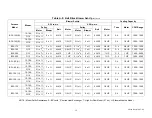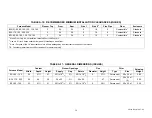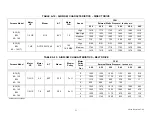
28141 Rev A 10-27-06
6
Furnace Power Requirements
Furnace
Model
Volts
AC
Amps
Phase
∅
Cycles
Hz
BCL (S)
120
15
1
60
BFL 120
15
1
60
BCL-170/190 120 15 1
60
BCL-200/225 120 20 1
60
Accessories requiring 120 VAC power sources
such as electronic air cleaners and humidifier
transformers may be powered from the furnace
circuit, but should have their own controls. Do not
use the direct drive motor connections as a power
source, since there is a high risk of damaging the
accessories by exposure to high voltage from the
auto-generating windings of the direct drive motor.
Thermostat wiring connections and air
conditioning contactor low voltage connections
are shown in the wiring diagrams in Appendix B.
Some micro-electronic thermostats require
additional controls and wiring. Refer to the
thermostat manufacturer's instructions.
The thermostat should be located approximately 5
feet above the floor, on an inside wall where there
is good natural air circulation, and where the
thermostat will be exposed to average room
temperatures. Avoid locations where the
thermostat will be exposed to cold drafts, heat
from nearby lamps and appliances, exposure to
sunlight, heat from inside wall stacks, etc.
The thermostat heat anticipator should be
adjusted to the amperage draw of the heating
control circuit as measured at the "R" and "W"
terminals of the thermostat. To reduce the risk of
damaging the heat anticipator, do not measure
this current with the thermostat connected to the
circuit. Measure the amperage by connecting an
ammeter between the two wires that will connect
to the thermostat "R" and "W" terminals.
11. HUMIDIFIER
A humidifier is an optional accessory available
through most heating supplies outlets. Installation
should be carried out in accordance with the
humidifier manufacturer's installation instructions.
Water or water droplets from the humidifier should
not be allowed to come into contact with the
furnace heat exchanger. Do not use direct drive
motor connections as a source of power for 120
VAC humidifiers and humidifier transformers.
12. PIPING INSTALLATION
The entire fuel system should be installed in
accordance with the requirement of CAN/CSA B-
139, and local regulations. Use only an approved
fuel oil tanks piping, fittings and oil filter.
In the United States the installation must be in
accordance with NFPA No. 31 and local codes
and authorities.
Install the oil filter as close to the burner as
possible. For further details of the oil supply tank
and piping requirements, please refer to the
instructions and illustrations in the oil burner
instructions shipped with the furnace.
13. OIL FILTER
All fuel systems should include an oil filter
between the fuel oil storage tank and the oil
burner. When using an oil burner nozzle smaller
than 0.65 U.S. Gallons Per Hour, install an
additional 7 to 10 micron filter as close as
possible to the oil burner.
14. OIL BURNER NOZZLES
The BCL (S) and BFL models are certified for
multiple firing rates, ranging from 80,000 to
145,000 Btu/h. By manipulating the oil burner
nozzle, flame retention head, static plate and
temperature rise. The BCL 190 model series is
certified for multiple firing rates ranging from
170,000 to 225,000 Btu/h. By manipulating the oil
burner nozzle, and temperature rise, these
furnaces may be fired at an ideal rate for a wide
range of structures. Refer to Table A-1, and the
furnace rating plate to determine the proper
combinations.
15. OIL BURNER ADJUSTMENT
The burner air supply is adjusted to maintain the
fuel to air
ratio
to obtain ideal combustion
conditions. A lack of air causes "soft" and "sooty"
flames, resulting in soot build-up throughout the
heat exchanger passages. Excess combustion air
causes a bright roaring fire and high stack
temperatures resulting in poor fuel efficiency. The
BCL and BFL furnaces operate most efficiently
with a No. 1 smoke spot on the Bacharach Scale.
This is not necessarily the optimum setting;
however, because dust will inevitably build up on
the air moving components of the oil burner
assembly. This will result in decreased air supply
with the potential result of soot building up in the
flue gas passageways of the heat exchanger.
Summary of Contents for BCL
Page 23: ...28141 Rev A 10 27 06 23 TABLE B 1 BECKETT AND RIELLO CHIMNEY VENTED WIRING DIAGRAM BCL S BFL ...
Page 24: ...28141 Rev A 10 27 06 24 TABLE B 2 BECKETT AND RIELLO DIRECT VENT WIRING DIAGRAM BCL S BFL ...
Page 29: ...29809 Rev A 10 19 2006 29 ...
Page 32: ...29809 Rev A 10 19 2006 32 ...
Page 36: ...29809 Rev A 10 19 2006 36 ...
Page 41: ...28141 Rev A 10 27 06 NOTES ...
Page 42: ...28141 Rev A 10 27 06 ...
Page 43: ...28141 Rev A 10 27 06 ...































